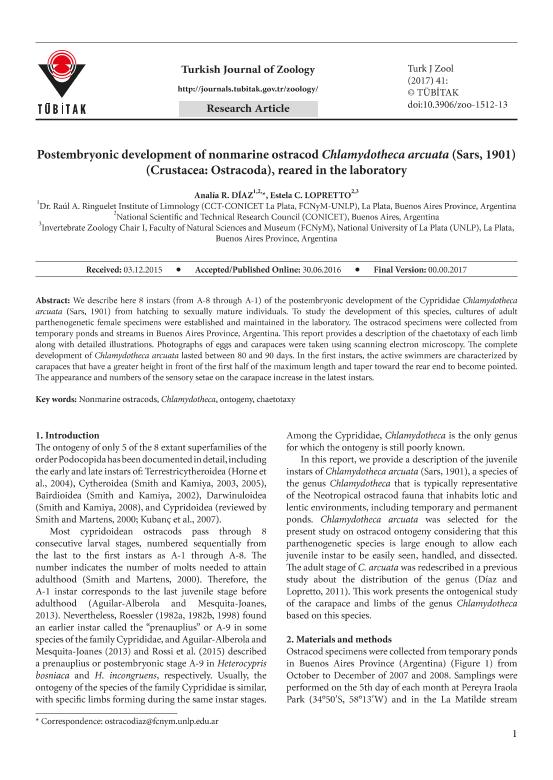Artículo
Postembryonic development of nonmarine ostracod Chlamydotheca arcuata (Sars, 1901) (Crustacea: Ostracoda), reared in the laboratory
Fecha de publicación:
01/2017
Editorial:
Tubitak Scientific & Technical Research Council Turkey
Revista:
Turkish Journal Of Zoology
ISSN:
1300-0179
e-ISSN:
1303-6114
Idioma:
Inglés
Tipo de recurso:
Artículo publicado
Clasificación temática:
Resumen
We describe here 8 instars (from A-8 through A-1) of the life cycle of the Cyprididae Chlamydotheca arcuata (Sars, 1901) from hatching to sexually mature individuals. To study the life cycle of this species, we established and maintained in the laboratory cultures from parthenogenetic adult females collected from temporary ponds and a stream in the Buenos Aires province, Argentina. This report provides a description of the chaetotaxy of each limb along with detailed illustrations. The eggs and the carapaces were photographed by scanning electron microscopy. The life cycle of Chlamydotheca arcuata lasted from 80 to 90 days. Females laid subitaneous eggs that hatched asynchronously. The conditions under which the culture was maintained were always the same; but only when the food changed from algae and bacteria to proteins, did the females start to lay many eggs. The food was the key to the development of the juveniles. In the first instars, those being active swimmers, the carapaces have a greater height in front of the first half of the maximum length and taper toward the rear end to become pointed. The appearance and number of the sensory setae on the carapace increase in the latest instars.
Palabras clave:
Nonmarine Ostracods
,
Chlamydotheca
,
Ontogeny
,
Chaetotaxy
Archivos asociados
Licencia
Identificadores
Colecciones
Articulos(ILPLA)
Articulos de INST.DE LIMNOLOGIA "DR. RAUL A. RINGUELET"
Articulos de INST.DE LIMNOLOGIA "DR. RAUL A. RINGUELET"
Citación
Diaz, Analia Roxana; Lopretto, Estela Celia; Postembryonic development of nonmarine ostracod Chlamydotheca arcuata (Sars, 1901) (Crustacea: Ostracoda), reared in the laboratory; Tubitak Scientific & Technical Research Council Turkey; Turkish Journal Of Zoology; 41; 2; 1-2017; 1-18
Compartir
Altmétricas




